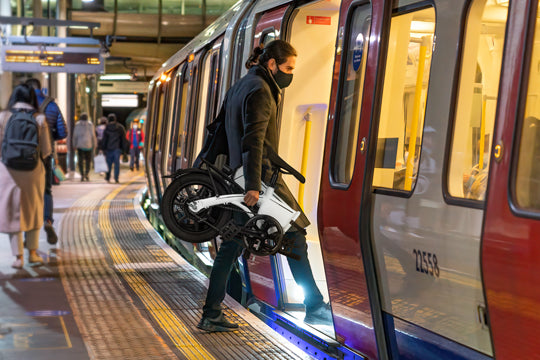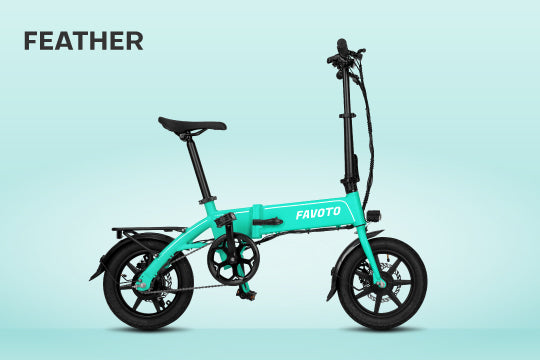What You Should Know About Fat Tire Ebikes?
Fat tire e-bikes, are bicycles that feature oversized tires and an electric motor that provides pedal assistance. It's designed to provide better flotation and traction on soft surfaces. The larger contact patch created by the wider tires helps to distribute the weight of the rider more evenly, reducing sinking into soft terrain and improving stability. The wider tires also provide a more comfortable ride, absorbing more of the impact from bumps and rough terrain.
Fat tire bikes, aka fat bikes, were developed in the early 2000s in response to the need for bikes that could handle the snowy terrain of Alaska. These bikes featured large, low-pressure tires that provided more surface area for better traction and stability on snow and other soft surfaces. The wider tires also helped to distribute the weight of the bike and rider, reducing the amount of sinking into soft surfaces like snow.
Fat tire bikes were initially used primarily for winter riding, but their versatility quickly became apparent. Riders discovered that the bikes were also well-suited for off-road riding and could handle a variety of terrain, including sand, mud, and rocks.

As the popularity of fat tire bikes grew, so did the technology. Electric fat tire bikes, or fat tire e-bikes, were introduced, providing an extra boost to riders tackling tough terrain. Suspension systems were also developed to improve the bikes' performance on rough terrain.
Today, fat tire bikes are widely used for everything from commuting and recreational riding to racing and adventure touring. They have become a popular choice forbikepacking and touring due to their stability and ability to handle a wide range of terrain.
Fat tire e-bikes are a great option for those who enjoy off-road cycling and want an extra boost to tackle tough terrain. With their wide tires, powerful motor, and long battery life, they offer a fun and versatile way to explore the outdoors.
Here are some things you should know about fat tire e-bikes:
- Tires: Fat tire e-bikes are so named because they have extra-large, wide tires that are usually around 4 inches or more in width, although some can be even wider. These tires provide extra traction and stability on rough or soft terrain, making them ideal for off-road riding.
- Motor: Fat tire e-bikes are powered by an electric motor that provides pedal assistance. The motor can be located in different places on the bike, such as the front or rear hub or the mid-drive, and can provide varying levels of power assistance to the rider.
-
Battery: The electric motor is powered by a battery, which is usually located on the frame of the bike. The battery can be removable or integrated into the frame and its capacity can vary, providing ranges from 20 to 80 miles on a single charge,depending on the e-bike model.
-
Pedal-assist and throttle modes:Fat tire e-bikes offer two modes of operation:pedal-assist and throttle. In pedal-assist mode, the motor provides assistance to the rider's pedaling efforts, allowing them to go farther and faster with less effort.In throttle mode, the motor provides power without the need for pedaling, making it more like a traditional electric scooter.
-
Terrain: Fat tire e-bikes are designed to handle a variety of terrains, from snow and sand to rocky trails and muddy paths. The wide tires and powerful motor make iteasier for riders to traverse rough terrain and inclines that might be difficult on a traditional bike.
-
Weight: Fat tire e-bikes can be heavier than traditional bikes due to the larger tires and the addition of the electric motor and battery. This can make them more difficult to transport or store, especially if you live in a small apartment or have limited storage space.
- Price: Fat tire e-bikes can be more expensive than traditional bikes due to the added features and technology. Prices can vary widely, depending on the quality of the components, motor power, battery capacity, and other features.

Here are a few factors contributing to fat tire e-bikes' growing popularity:
-
Versatility: Fat tire e-bikes are versatile and can handle a wide range of terrain,including snow, sand, mud, and rocks. They are well-suited for off-road riding,bikepacking, and touring, making them a popular choice for adventure enthusiasts.
-
Comfort: The wider tires on fat tire e-bikes provide a more comfortable ride,absorbing more of the impact from bumps and rough terrain. Additionally, the electric motor provides extra assistance, making it easier to tackle challenging terrain.
-
Accessibility: The electric motor on fat tire e-bikes makes riding more accessible for people who might not otherwise be able to ride a traditional bike. The motor provides assistance when climbing hills or when riding into headwinds, making it easier for people of all fitness levels to enjoy biking.
-
Sustainability: Fat tire e-bikes are more sustainable than traditional gas-powered vehicles, as they produce no emissions and can be charged using renewable energy sources like solar power.
-
Fun: Finally, fat tire e-bikes are simply a lot of fun to ride! They provide an exciting and adventurous way to explore the great outdoors, and the combination of the electric motor and the wide tires allows riders to tackle terrain that might otherwise be too challenging.

When choosing fat tires for your bike, there are a few important factors to consider.Here are some key aspects to keep in mind:
- Diameter: Fat tires come in different diameters, and it's important to choose a tire that is compatible with your bike's rim size. The most common fat tire diameter is 26 inches, but 27.5 and 29 inches are also available. Make sure to check your bike's specifications to determine the appropriate tire diameter.
- Width: Fat tires are wider than traditional bike tires, and the width can vary between different models. The most common fat tire width is around 4 inches, but some can be even wider. The width of the tire affects how much flotation it provides on soft surfaces and how much stability it provides on rough terrain. A wider tire may provide better flotation, while a narrower tire may provide better maneuverability. Consider the type of terrain you will be riding on when choosing the width of your fat tires.
-
Pattern: The tread pattern of fat tires can vary depending on the intended use of the tire. Some tires have a more aggressive tread pattern with larger knobs, which provides better traction on loose or soft terrain. Other tires have a smoother tread pattern, which provides better speed and maneuverability on hard surfaces.
Consider the type of terrain you will be riding on when choosing the tread pattern of your fat tires.




